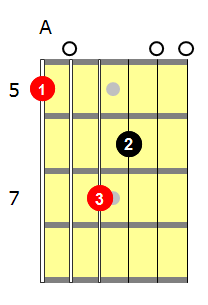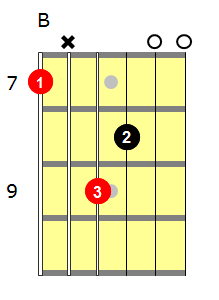Day 5 already. Hopefully you’ve been practicing the chords so far and found a way to incorporate them into songs you’re playing.
Today’s chords flow on from the E chord we learnt yesterday. Here’s a link to yesterday’s lesson if you need to refresh your memory.
Let’s look at the A chord. This is based around the A barre chord that you’d play on the 5th fret, using an E shape. In this chord, we don’t barre, and instead add some open strings to the chord (like we did with the E chord yesterday).
Look at the bottom two strings. You’re playing two ‘A’ notes – one on the 5th fret, and the other using the open A string. This is a similar concept to the E chord you learnt yesterday where the E note was on the bottom two strings.
We’re also keeping the top two string open. This adds a B note and an E note. The E is already part of the A chord. The B isn’t, and adding it makes the chord into an Asus2 (we learnt a different version of this in an earlier lesson).
This chord (and the B below) fit perfectly with the E chord from yesterday’s lesson.
The B Chord
The B is exactly the same shape as the A chord, it’s just moved up two frets.
In this chord, you need to mute the A string – this is easy to do with the edge of your first finger.
The top two notes are the B and E again – the two open strings. The B belongs in the B chord. The E is the 4th of the B major scale, so it turns the chord into a Bsus4 chord.
Compare this chord to the E chord from yesterday’s lesson, and you’ll see that the two chords are very similar.
I like to play a bar of the E chord and then a bar of this B chord. All you need to do is move your first finger and drop the 4th finger to the 2nd – check out how I do it on the video.
Practice playing these chords together with the E shape from yesterday’s lesson. You’ll be able to play any song in the key of E using the open sounding chords.
Hope you’ve found this lesson useful. See you tomorrow.

